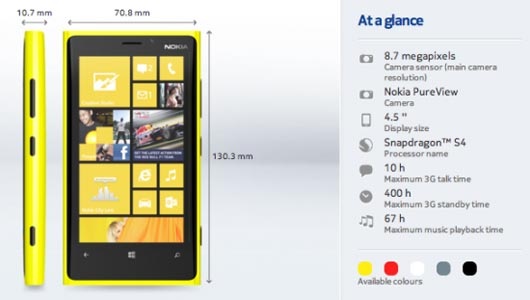Nokia’s next flagship handset, Nokia Lumia 920 is all set to take the reins from the Nokia Lumia 900. Recently the Finnish firm has been through hard times with its own Symbian OS failing to deliver. Even partnering with Microsoft hasn’t proved to be a successful effort, as it is struggling to compete with iOS and Android.
Now Microsoft is launching the much-anticipated Windows Phone 8, which brings with it a lot more flexibility for homescreen tiles and sizing. Along with this it also supports proper multi-tasking, support for more powerful hardware and a lot of other eye-catching features. So we all know that Windows Phone 8 will power the Nokia Lumia 920, giving the consumers their first taste of this new OS.
Design
At first glance it looks much like its predecessor the Nokia Lumia 900. Both are angular, with polycarbonate coating and both are available in a blinding array of colors.
But while looking closely at it you will notice that the Nokia Lumia 920 has a slightly bigger display of 4.5-inches as compared to 4.3-inches for the Nokia Lumia 900.
Specifications
It’s got a plentiful 32GB of internal storage space. It has a 1.5GHz dual core Snapdragon S4 processor and thus has taken the Windows Phone into dual-core zone. Well it also sports 1GB of RAM to help power things along.
PureView
The spotlight feature of the Nokia Lumia 920 is undoubtedly the ‘PureView’ technology powering the camera. On hearing this first thing that strikes our mind is Nokia 808 PureView. The Nokia 808 PureView sets the bar for all camera phones with its gargantuan 41MP lens. Nokia’s Lumia 920 doesn’t have as much of that amazing technology, 920’s lens is a fairly standard 8.7 megapixels.
But don’t get disheartened, because the other features are going to earn it the name. According to Nokia’s statement this is the second phase in PureView technology and includes some of the core pieces such as powerful image processing algorithms and high performance Carl Zeiss lenses.
Carl Zeiss lens means much cleaner and sharper images. Using ‘floating lens technology’, it can compensate for shaky hands, plus it can capture up to ten times more light than other smartphone cameras, which should lead to brighter, blur free images. Low light performance is a major feature in this new camera, along with video image stabilization.
There’s also a 1.3 megapixel front facing camera, capable of recording 720p video, making it fit for Skype and the like.
Super Sensitive Touchscreen
It works with fingernails, fingertips, and fingers covered with gloves!! The display is ‘super sensitive’ to the touch. Its sensitivity adapts depending on what you’re using on it, which should allow for more accurate and flexible use.And it has a pixel density of 332ppi, beating the iPhone 4S’s retina-display with 326ppi.
Puremotion HD+

The Nokia Lumia 900 has a ClearBlack display and some testing revealed the 900 has a better outdoor display than the iPhone 4S and Galaxy S. Nokia is now taking that ClearBlack display technology to the next level. So if you were wondering that the curved-glass WXGA display with resolution of 1280×768 pixels is the most exciting feature then of Lumia 920 then think again. With the PureMotion HD+ technology Nokia is making a claim that “it provides a better than HD experience” and this technology looks to be the leading display on smartphones today.
It’s 25% brighter than the next brightest smartphone display in the market. It can detect how much light is hitting the screen and automatically adjusts to sunlight glare so that you can still see the display.
It can also supposedly both render objects and refresh the screen faster than other Smartphones (nearly 2.5x), resulting in a smoother, blur free image when watching video, playing games or just operating the phone. New the ‘HD+’ feature. It actually refers to the aspect ratio of the handset, which is 15:9 rather than the HD standard of 16:9 and is a better fit for the phone.
Nokia Maps
Nokia is in a quest of getting some differentiation from the rest of the smartphone pack. Nokia is doing this by stuffing as much apps as possible in the Lumia 920. The bet service ever offered by Nokia is Nokia Maps. More impressively City Lens a new augmented reality feature is integrated with Nokia Maps. It displays information such as restaurant names and other points of interest when you point the phone at them. It remains to be seen whether that’s any more useful than seeing them on a map.
Furthermore, Nokia Drive is integrated with the mapping software so you can save maps for offline viewing with free turn-by-turn navigation, daily commute and local traffic reports. Nokia Maps further integrates Nokia Transport which displays public transport information, including multiple routes and times for buses and trains.
NFC and battery
It is not a feature to be much hyped about but still it is something unique that distinguishes the Nokia Lumia from other Windows Phone 8 devices. The Nokia Lumia 920 also features an NFC chip and wireless charging technology. In practice that means putting it on a ‘charging pad,’ a device which may one day soon become a common staple of coffee shops and bars, making it easy to charge on the go.
The partnership deal with coffee shops is excellent. Right now these pads have been announced for Coffee Bean and Tea Leaf, and for the London Heathrow Virgin Atlantic lounge, but there’s bound to be more coming. It’s even packed with an enormous 2000mAh battery.
It’s time to talk about the down side now.
First thing to mention is the weight, with 185g it’s quite heavy and a bit thick with 10.7 mm as compared to its competitors. And also Lumia has no microSD card slot. Of course with 32 GB internal storage there is no need of one but still as it is Nokia’s flagship device it is quite disappointing for this drawback


